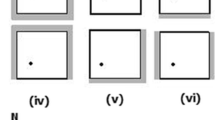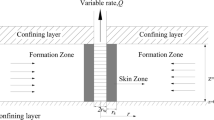Abstract
The analysis of the capture zone of wells is useful to design pumping systems and wellhead protection programs. In this study, an analytical solution for the head distribution of a partially penetrating well, and semi-analytical methods to determine the geometry of the capture surface are presented. The analytical solution is derived based on an infinitesimal radius under a constant pumping rate in a two-zone confined aquifer. Using the developed solution, a sensitivity analysis is performed to study the influence of skin on the drawdown, location of the stagnation point, maximum horizontal and vertical extent of the capture surface. The results show the efficiency of a partially penetrating well in the plume removal process is different for positive and negative skins. Also it can be concluded, the skin effect will decrease as the degree of penetration and pumping discharge of the well increase. Generally, the thickness of the skin zone is an influential factor in well hydraulics and hydraulic head distribution. However, it can be seen where the skin zone is less than some specific values, the skin effect is not a significant factor, thus, the geometry of the capture surface can be obtained by assuming a single-zone aquifer. Moreover, the effects of different parameters (pumping rates, degree of penetration of the well, thickness of the skin zone, etc.) on the capture zone are studied.
Similar content being viewed by others
Abbreviations
- Q :
-
Constant pumping rate [L3 T−1]
- K r :
-
Horizontal hydraulic conductivity of the aquifer [LT−1]
- K z :
-
Vertical hydraulic conductivity of the aquifer [LT−1]
- K :
-
Hydraulic conductivity of isotropic aquifer [LT−1]
- H(r, z):
-
Drawdown [L]
- \({\tilde {H}(r,n)}\) :
-
Drawdown in Fourier domain
- R :
-
Radial distance from the well [L]
- Z :
-
Vertical distance [L]
- U :
-
Darcy velocity [LT−1]
- r s :
-
Radius of the skin zone [L]
- r w :
-
Radius of the capture well [L]
- R :
-
Radius of the influence of the well [L]
- L :
-
Thickness of the aquifer [L]
- B 1 :
-
Upper limit of the screen of the well [L]
- B 2 :
-
Lower limit of the screen of the well [L]
- n :
-
Fourier transform of variable z
- \({\phi_u}\) :
-
Velocity potential due to regional flow [L2 T−1]
- \({\phi_w}\) :
-
Velocity potential due to pumping well [L2 T−1]
- U :
-
Discharge component in x direction [LT−1]
- V :
-
Discharge component in y direction [LT−1]
- W :
-
Discharge component in z direction [LT−1]
- I 0(u):
-
Modified Bessel function of the first kind of order zero
- K 0(u):
-
Modified Bessel function of the second kind of order zero
References
Abramowitz M., Stegun I.A.: Handbook of Mathematical Functions with Formulas Graphs and Mathematical Tables. National Bureau of Standards, Dover, Washington (1964)
Bakker M., Strack O.D.L.: Capture zone delineation in two-dimensional groundwater flow models. Water Res. Res. 32(5), 1309–1315 (1996)
Bourdarot G.: Well testing: interpretation methods. Center for petroleum engineering and project development, Paris (1998)
Cassiani G., Kabala Z.J.: Hydraulics of a partially penetrating well: solution to a mixed-type boundary value problem via dual integral equations. J. Hydrol. 211, 100–111 (1998)
Cassiani G., Kabala Z.J., Medina M.A.: Flowing partially penetrating well: solution to a mixed-type boundary value problem. Adv. Water Res. 23, 59–68 (1999)
Chang, C.C., Chen, C.S.: Analysis of constant-head for a two-layer radially symmetric nonuniform model. In: Proceedings of 3rd Groundwater Resources and Water Quality Protection Conference. National Central University. Chung-Li, Taiwan (1999)
Chang C.C., Chen C.S.: An integral transform approach for a mixed boundary problem involving a flowing partially penetrating well with infinitesimal well skin. Water Resour. Res. 38(6), SBH7–1 (2002)
Chang C.C., Chen C.S.: A flowing partially penetrating well in a finite-thickness aquifer: a mixed-type initial boundary value problem. J. Hydrol. 271, 101–118 (2003)
Chen C.S., Chang C.C.: Theatrical evaluation of non-uniform skin effect on aquifer response under constant rate pumping. J. Hydrol. 317, 190–201 (2006)
Christ J.A., Goltz M.N.: Development and application of an analytical model to aid design and implementation of in situ remediation technologies. J. Contaminant Hydrol. 37, 295–317 (1999)
Christ J.A., Goltz M.N.: Hydraulic containment: analytical and semi-analytical models for capture zone curve delineation. J. Hydrol. 262, 224–244 (2002)
Christ J.A., Goltz M.N.: Containment of groundwater contamination plumes: minimizing drawdown by aligning capture wells parallel to regional flow. J. Hydrol. 286, 52–68 (2004)
Eradmann J.B.: On capture width and capture zone gaps in multiple-well systems. Ground Water 38(4), 497–504 (2000)
Faybishenko B.A., Javandel I., Witherspoon P.A.: Hydrodynamics of the capture zone of a partially penetrating well in a confined aquifer. Water Resour. Res. 31(4), 859–866 (1995)
Fienen M.N., Lou J., Kitanidis P.K.: Semi-analytical homogeneous anisotropic capture zone delineation. J. Hydrol. 312, 39–50 (2005)
Grubb S.: Analytical model for estimating of steady-state capture zone of pumping wells in confined aquifers. Ground Water 31(1), 27–32 (1993)
Javandel, I.: Analytical solutions in subsurface fluid flow. Geol. Soc. Am. Spec. Paper 189, 223–235 (1982)
Javandel I., Tsang C.F.: Capture-zone type curves: a tool for aquifer cleanup. Ground Water 24(5), 616–625 (1986)
Novakowski K.S.: Interpretation of the transient flow rate obtained from constant-head tests conducted in situ in clays. Can. Geotech. J. 30, 600–606 (1993)
Perina T., Lee T.C.: General well function from a confined, leaky and unconfined aquifer. J. Hydrol. 317, 239–260 (2006)
Shan C.: An analytical solution for the capture zone of two arbitrary located wells. J. Hydrol. 222, 123–128 (1999)
Strack O.D.L.: Groundwater Mechanics, pp. 227–240. Prentice-Hall, Englewood Cliffs (1989)
Todd D.K., Mays L.W.: Groundwater Hydrology, 3rd edn. Wiley, New York (2005)
Yang S.Y., Yeh H.D.: Solution for flow rates across the wellbore in a two-zone confined aquifer. J. Hydraul. Eng. 128(2), 175–183 (2002)
Yang S.Y., Yeh H.D.: Laplace-domain solutions for radial two-zone flow solutions under the conditions of constant-head and partially penetrating well. J. Hydraul. Eng. 131(3), 209–216 (2005)
Yang, Y.J., Spencer, R.D., Todd, M.G.: Analytical solutions for determination of non-steady-state and steady-state capture zones. Ground Water Monit. Remediat. 101–106 (1995)
Zhan H.: Analytical study of capture time to a horizontal well. J. Hydrol. 217, 46–54 (1999)
Author information
Authors and Affiliations
Corresponding author
Rights and permissions
About this article
Cite this article
Ataie-Ashtiani, B., Shafei, B., Rashidian-Dezfouli, H. et al. Capture Zone of a Partially Penetrating Well with Skin Effects in Confined Aquifers. Transp Porous Med 91, 437–457 (2012). https://doi.org/10.1007/s11242-011-9853-3
Received:
Accepted:
Published:
Issue Date:
DOI: https://doi.org/10.1007/s11242-011-9853-3




